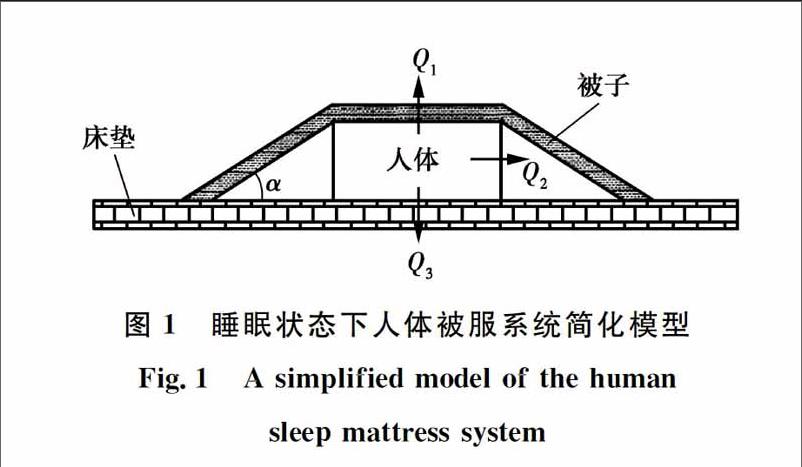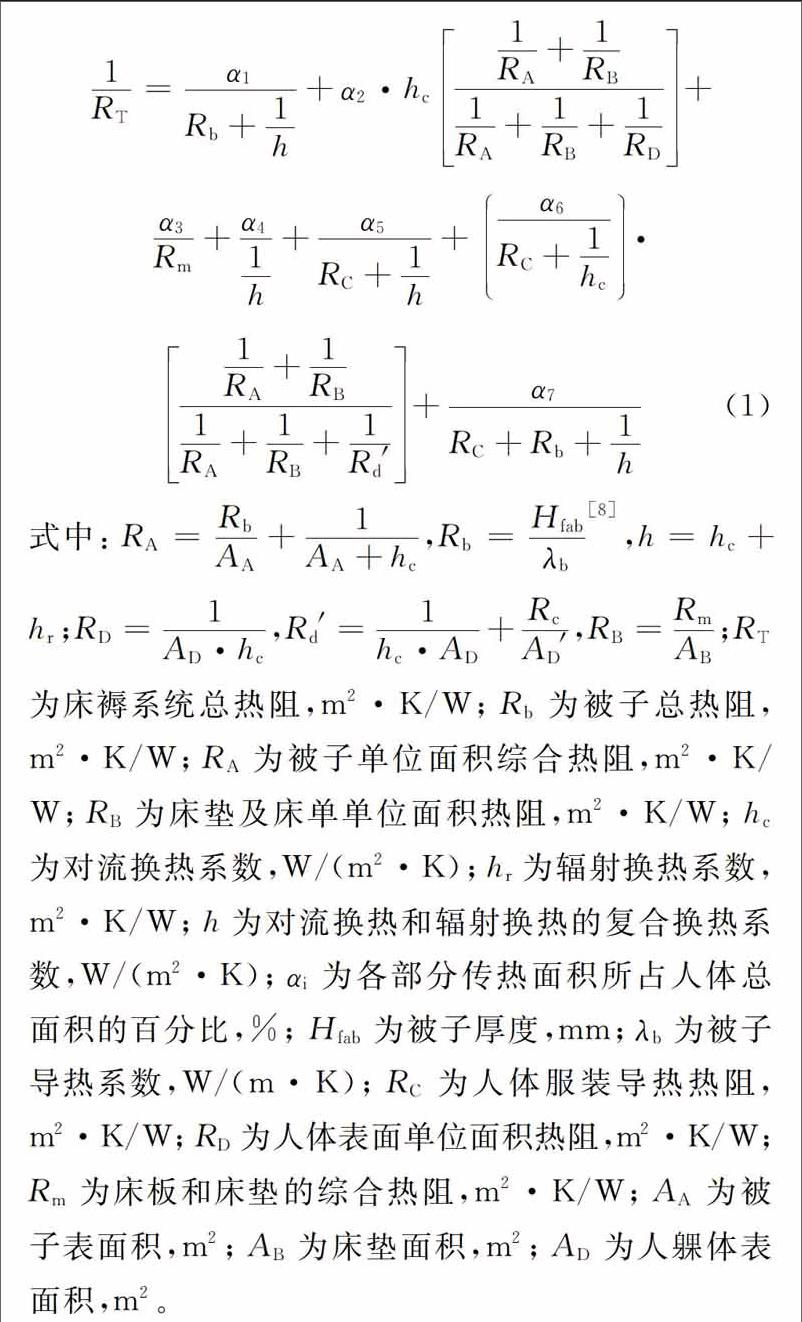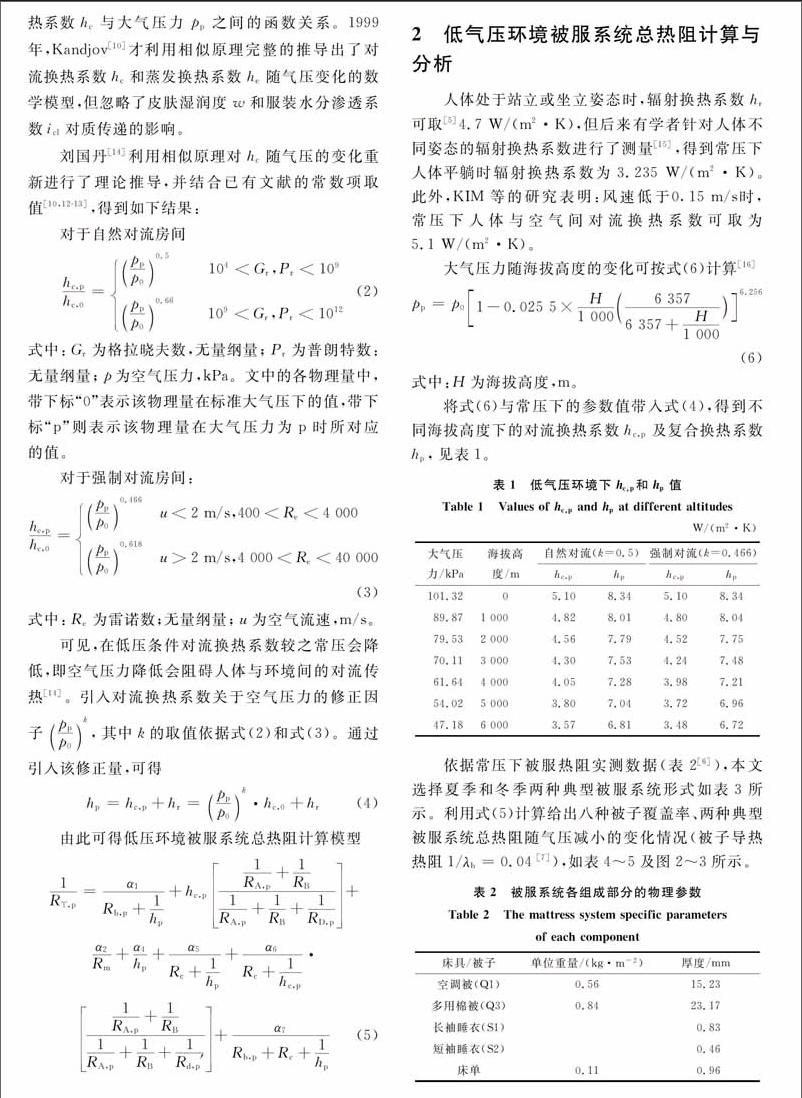低气压环境被服系统总热阻计算模型
张华玲++姚大军++洪诗尧



摘要:
服装热阻是影响人体热舒适的重要因素之一,夜间睡眠状态下的被服系统总热阻包括人体所穿服装热阻与整个床褥系统热阻。针对低气压环境,目前,尚缺乏被服热阻实验数据,也没有可参考的被服系统总热阻的理论计算模型。以人体睡眠状态被服系统总热阻计算方法为依据,引入气压修正项对相关参数进行修正,建立了适用于低气压环境的被服系统总热阻的修正计算模型,并用模型计算了冬夏典型被服系统总热阻,分析了气压减小对总热阻的影响,发现冬夏季被服系统总热阻均随大气压力降低而升高,增加百分比最大值均为42%,且均出现在被子覆盖率为23.3%的条件下,当海拔低于3 000 m时,由被子覆盖率引起的被服系统总热阻增加系数不超过0.05。
关键词:
低气压环境;病人;被服系统总热阻;压力修正;计算模型
Abstract:
Clothing thermal resistance is a key factor that affects the thermal comfort of human body. The total thermal resistance of bedding and clothing system in sleeping at night includes the clothing system resistance and the body of the mattress system. In the low pressure environment, there is still a lack of experimental data and calculation model of thermal resistance, with no reference to theory models. In this paper, based on calculation method of the total thermal resistance of bedding and clothing system in sleeping, the calculation model of total thermal resistance in low pressure environment is established by the introduction of pressure correction of related parameters. The typical total thermal resistance both summer and winter is calculated using the model. The variation rules of total thermal resistance caused by the pressure reducing is obtained. At altitude of less than 3000m, the increasing coefficient of total thermal resistance of bedding and clothing system caused by the coverage ratio of blanket is not more than 0.05. The total thermal resistances both winter and summer increase with atmospheric pressure decreasing. There is a same maximum percentage of 42% under the condition of 23.3% of blanket coverage.
Keywords:
low pressure environment; patients; total thermal resistance; pressure correction; calculation model
目前,人體热舒适研究主要关注于日间不同活动水平[14],服装热阻取决于人体所穿的衣物及所带配饰,主要采用ASHRAE手册中给出的计算方法[5]。夜间睡眠状态下的被服系统总热阻除了所穿衣物热阻外还包括整个床褥系统的热阻,文献[5]给出的公式计算睡眠状态下的人体总热阻将会存在较大的误差,Lin等[6]给出了常压下人体睡眠状态被服系统总热阻计算模型,并给出了不同材质与厚度床褥系统热阻在常压下的实验测试值。研究低气压下的人体睡眠状态热舒适,首先需要计算或测试低气压环境床褥系统的热阻,但目前还未见文献给出基础数据。由于低气压环境人体在睡眠状态的总热阻与在常压下环境计算方法基本相同,因此,为减少实验测试工作量,本文通过理论方法给出气压降低对被服系统总热阻计算的修正模型,并基于已有的常压环境热阻实验数据,为低气压环境人体睡眠状态的热舒适或普通病房病人的热舒适研究奠定了基础。
1低气压环境被服系统总热阻修正模型
1.1常压环境被服系统总热阻模型
文献[6]将睡眠状态下人体与被服系统传热的物理模型简化为图1所示。
人体散热包括:被子与皮肤直接接触部分的传热量Q1、被子与皮肤之间的空气夹层的接触部分的传热量Q2、人体皮肤与床垫接触部分的传热量Q3、人体外露皮肤与室内空气直接接触部分的传热量Q4、穿着服装与周围环境间的传热量Q5、穿着的衣服和被子之间的换热量Q6、服装和被子重叠部分与周围空气间的换热量Q7等7部分。应用能量守恒定律,通过推导得出了睡眠状态下人体被服系统总热阻计算模型[7],如式(1)。
1.2气压减小对被服系统热阻的修正
依据常压下被服热阻实测数据(表2[6]),本文选择夏季和冬季两种典型被服系统形式如表3所示。利用式(5)计算给出八种被子覆盖率、两种典型被服系统总热阻随气压减小的变化情况(被子导热热阻1/λb=0.04[7]),如表4~5及图2~3所示。
由以上计算结果分析可知,在相同被子覆盖率条件下,冬夏季被服系统总热阻均随大气压力降低而升高,且冬夏季被服系统热阻随大气压力降低的增加百分比最大值都出现在被子覆盖率为23.3%的条件下,均为42%;同一气压条件,冬夏季被服系统总热阻均随覆盖率的增加而增加,但增加系数随覆盖率的增加而降低,且增加百分比的极值差均不超过0.1。在海拔低于3 000 m的条件下,由被子覆盖率引起的被服系统总热阻增加系数不超过0.05,即可以认为海拔不超过3 000 m的条件下被子覆盖率对被服系统总热阻变化的影响很小。
3结论
1)通过理论推导,在林中平教授所建立的睡眠条件下被服系统总热阻计算模型的基础上建立了低气压不同大气压力(海拔高度)下睡眠状态被服系统总热阻的计算模型。
2)通过该模型计算得到了冬夏两季不同海拔高度下两种典型被服系统组合在不同被子覆盖率条件下的被服系统总热阻。通过分析计算结果,得出了不同大气压力下的被服系统总热阻的变化规律:在海拔低于3 000 m的条件下,被子覆盖率对被服系统总热阻变化的影响很小。冬夏季被服系统总热阻均随大气压力降低而升高,增加百分比最大值均为42%,且均出现在被子覆盖率为23.3%的条件下。
3)利用本文所建立的热阻计算模型,在不进行实验测量的条件下便可计算得到不同大气压力下被服系统的总热阻。
参考文献:
[1] NOL D Y, REN T D, DONATIEN N. Thermal comfort: A review paper [J]. Renewable and Sustainable Energy Reviews, 2010, 14:26262640.
[2] THAMMANOON S, VEERAPOL M, SIRICHAI T. Assessment of the thermal environment effects on human comfort and health for the development of novel air conditioning system in tropical regions [J]. Energy and Buildings, 2010, 42:16921702.
[3] 倪冬香,范秦寅,TAKAO ITAMI.考虑了人体新陈代谢的乘员舱舒适性分析[C]//第五届中国 CAE工程分析技术年会论文集,2009:425429.
NI D X, FAN Q Y, TAKAO I. Analysis of occupant comfort in human body metabolism [C]//Proceedings of the Fifth China CAE Engineering Analysis Technology Symposium, 2009: 425429.
[4] 田元媛,許为全.热湿环境下人体热反应的实验研究[J]. 暖通空调,2003,33(4):2730.
TIAN Y Y, XU W Q. experimental study on thermal environment for the whole human thermal response[J]. HV & AC , 2003,33(4):2730.
[5] ASHRAE. ASHRAE handbook of fundamentals[S]. 2010.
[6] LIN Z P, DENG S M. A study on the thermal comfort in sleeping environments in the subtropics—Measuring the total insulation values for the bedding systems commonly used in the subtropics [J]. Building and Environment, 2008,43: 905916.
[7] 潘冬梅.睡眠环境人体热舒适实验研究[D].上海:同济大学,2009:2130.
PAN D M. Human thermal comfort sleep environment experimental study [D].Shanghai: Tongji University, 2009: 2130.
[8] KIM J S, OH H B, KIM A H. Radiative and convective heat transfer coefficients of the human body in natural convection[J]. Building and Environment, 2008,12(43):21422153.
[9]
KANDJOV I. Wrmeund masseaustausch zwischen menschlichem Krper und Umgebungsluft. Einwirkung der Meereshhe [J]. Phys Rehab Kur Med, 1988, 40(5):299306.
[10] KANDJOV I M. Heat and mass exchange processes between the surface of the human body and ambient air at various altitudes [J]. International Journal of Biometeorology, 1999, 43(1): 3844.
[11] RICHARD J D, ARENS E, HUI Z, et al. Convective and radiative heat transfer coefficients for individual human body segments [J]. International Journal of Biometeorology, 1997,40(3): 141156.
[12] 杨世铭,陶文铨.传热学[M]. 北京:高等教育出版社,2006:256269.
YANG S M, TAO W Q. Heat transfer [M]. Beijing: Higher Education Press, 2006:256269.
[13] GAGGE A P. A standard predictive index of human response to the thermal environment[J]. ASHRAE Trans, 1986, 92: 709731.
[14] 刘国丹.无症状高原反应域低气压环境下人体热舒适研究[D].西安:西安建筑科技大学,2008:4955.
LIU G D. Asymptomatic high altitude reaction in the low pressure environment of human thermal comfort study [D]. Xi'an:Xi'an University of Architecture and Technology, 2008: 4955.
[15] YOSHIHITO, KURAZUMI, TADAHIRO, et al. Radiate and convective heat transfer coefficient of the human body in natural convection [J]. Building and Environment, 2008, 43(12):24132153.
[16] 火力發电厂燃烧系统设计计算技术规程:DL/T 5240—2010[S].
Technical code for design and calculation of combustion system in thermal power plant:DL/T 52402010 [S].

